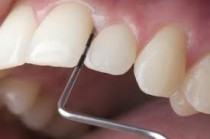Periodontitis: saving teeth
For sound teeth, sound gums are extremely important as well.
An inflammation of the gums or the jaw bone - called periodontitis - can damage your set of teeth and can end in tooth loss. In order to avoid this, we start with an appropriate therapy in time. So we can stop that process and save your dentalhealth.
A periodontitis is caused by bacterial plaque, which remains in interdental spaces, niches or under overhanging crown margins. These bacteria irritate the gums - only superficially, but constantly. The organism is respondig by launching a chronic inflammation. In the course of that defensive reaction, which actually is natural, initially the superficial gums are weakened. Later on the bone is receeding, too. Then gum pockets can be seen. The bacteria dispread deeper and deeper along the root surfaces and transport the infection into the tissue. The alveolar bone gets destroyed batch-wise, the teeth get loose. However the inflammation and the germs do not only harm the tissues around the teeth, but other organs of the body.
How can I know that I have periodontitis
It is a big problem that usually patients do not notice a gum disease themselves. Gum diseases mostly do not cause any pain. And when they spot a problem, often it is too late for a successful treatment. The symptoms of an early periodontitis are very discreet: sometimes bleeding, reddened gums, later on the interdental spaces are becoming opener. The key criterium for the diagnosis periodontitis - the bone loss - can be assessed only by probing and x-rays.
treatment of periodontitis
Our treatment of periodontitis consists of
- sysstematical infection therapy
- antimicrobial photodynamic laser therapy (Helbo)
- regenerative therapy (Emdogain)
The treatment is carried out step by step. Usually it takes 5 or 6 appointments. First of all we care for the superficial gums to heal up from inflammation. This is a precondition for proceeding to the root surfaces underneath the gum line. The teeth will be cleaned and disinfected with fine instruments, ultrasonics, antiseptics and with a special laser, so that the gums are able to adapt to the teeth again. This tight connection will stop the bone loss. However the deep gum pockets remain in the first instance, they are quite prone to new infection. For a long-term success it is therefore necessary to avoid new bacterial colonisation. For this reason a tooth cleaning has to be carried out every 3 to 6 months after the gum disease treatment. This is what we call "supporting treatment of periodontitis". It means that we check your gums on a regular basis and determine according to current scientific criteria, how often the supporting treatment is recommended. The tooth cleaning includes an ultrasonic rinsing of the remaining gum pockets in order to eliminate newly colonizing germs.




